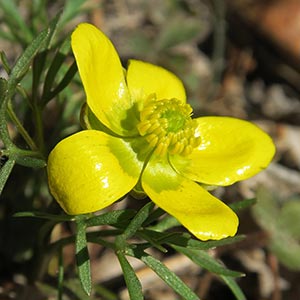Ranunculus sceleratus
Ranunculus triternatus
blister buttercup, celery-leaf buttercup, celery-leaf crowfoot, cursed buttercup, cursed crowfoot, cursed crowsfoot, renoncule scélérate
Dalles Mountain buttercup, obscure buttercup
cylindric, 2-3 mm thick.
erect, glabrous, rooting at base, only very rarely rooting at proximal nodes.
prostrate or ascending, 5-20 cm, glabrous, each with 1-6 flowers.
basal and cauline, basal and proximal cauline leaf blades reniform to semicircular in outline, 3-lobed or -parted, 1-5 × 1.6-6.8 cm, base truncate to cordate, segments usually again lobed or parted, sometimes undivided, margins crenate or crenate-lobulate, apex rounded or occasionally obtuse.
persistent, blades rhombic to deltate or reniform in outline, 3-4x-dissected, 1.1-3.4 × 2-3.1 cm, segments linear, base obtuse, margins crenate, apices of segments narrowly rounded.
receptacle pubescent or glabrous;
sepals 3-5, reflexed from or near base, 2-5 × 1-3 mm, glabrous or sparsely hirsute;
petals 3-5, 2-5 × 1-3 mm;
nectary on petal surface, scale poorly developed and forming crescent-shaped or circular ridge surrounding but not covering nectary;
style absent.
pedicels glabrous;
receptacle short-pubescent;
sepals 4-8 × 2-5 mm, abaxially glabrous or nearly so;
petals 5, 6-15 × 4-10 mm;
nectary scale glabrous.
ellipsoid or cylindric heads, 5-13 × 3-7 mm;
achenes 1-1.2 × 0.8-1 mm, glabrous;
beak deltate, usually straight, 0.1 mm.
depressed-globose, 4-6 × 5-8 mm;
achenes 1.8-2.2 × 1.2-1.8 mm, finely pubescent;
beak subulate, straight, 0.8-1.5 mm.
Ranunculus sceleratus
Ranunculus triternatus
Varieties 2 (2 in the flora).
Ranunculus sceleratus varieties were used by the Thompson Indians as a poison for their arrow points (D. E. Moerman 1986).
(Discussion copyrighted by Flora of North America; reprinted with permission.)
Of conservation concern.
C. L. Hitchcock et al. (1955-1969, vol. 2) considered the name Ranunculus triternatus A. Gray to be an illegitemate homonym and used the illegitimate (superfluous) name R. reconditus A. Nelson & J. F. Macbride for this species. The name Ranunculus triternatus Poiret was not validly published (not accepted by Poiret) and does not invalidate R. triternatus A. Gray.
(Discussion copyrighted by Flora of North America; reprinted with permission.)
1. Faces of achene with fine transverse wrinkles; leaf blades lobed or parted, segments undivided or lobed, margins crenate. | var. sceleratus |
1. Faces of achene smooth; leaf blades always parted (often deeply so), segments lobed or parted, margins deeply crenate or lobulate. | var. multifidus |
- Local floras:
BC,
CA,
OR,
WA
- Local Web sites:
CalFlora,
CalPhotos,
Flora NW,
Go Botany,
IL Wildflowers,
KS Wildflowers,
LA Plants,
MD Biodiversity,
MI Flora,
MN Wildflowers,
MO Plants,
PNW Herbaria,
Turner Photog.
WildflowerSearch
iNaturalist (observations)
USDA Plants Database
- LBJ Wildflower Center
- SEINet
- Plants of the World Online
- Encyclopedia of Life
- Wikipedia
- Google Image Search
